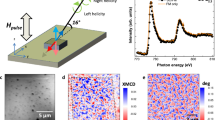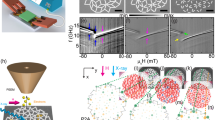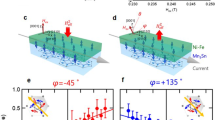Abstract
Although ferromagnetism is known to be of enormous importance, the exploitation of materials with a compensated (for example, antiferromagnetic) arrangement of long-range ordered magnetic moments is still in its infancy. Antiferromagnetism is more robust against external perturbations, exhibits ultrafast responses of the spin system1 and is key to phenomena such as exchange bias2,3, magnetically induced ferroelectricity4 or certain magnetoresistance phenomena5. However, there is no conjugate field for the manipulation of antiferromagnetic order, hindering both its observation and direct manipulation. Only recently, direct poling of a particular antiferromagnet was achieved with spintronic approaches6. An interesting alternative to antiferromagnetism is ferrotoroidicity—a recently established fourth form of ferroic order7,8. This is defined as a vortex-like magnetic state with zero net magnetization, yet with a spontaneously occurring toroidal moment9. As a hallmark of ferroic order, there must be a conjugate field that can manipulate the order parameter. For ferrotoroidic materials, this is a toroidal field—a magnetic vortex field violating both space-inversion and time-reversal symmetry analogous to the toroidal moment10. However, the nature and generation of the toroidal field remain elusive for conventional crystalline systems. Here, we demonstrate the creation of an artificial crystal11,12 consisting of mesoscopic planar nanomagnets with a magneto-toroidal-ordered ground state. Effective toroidal fields of either sign are applied by scanning a magnetic tip over the crystal. Thus, we achieve local control over the orientation of the toroidal moment despite its zero net magnetization.
This is a preview of subscription content, access via your institution
Access options
Access Nature and 54 other Nature Portfolio journals
Get Nature+, our best-value online-access subscription
$29.99 / 30 days
cancel any time
Subscribe to this journal
Receive 12 print issues and online access
$259.00 per year
only $21.58 per issue
Buy this article
- Purchase on Springer Link
- Instant access to full article PDF
Prices may be subject to local taxes which are calculated during checkout




Similar content being viewed by others
Data availability
The data that support the figures within this paper and other findings of this study are available from the corresponding authors upon reasonable request.
References
Sander, D. et al. The 2017 Magnetism Roadmap. J. Phys. D 50, 363001 (2017).
Meiklejohn, W. H. & Bean, C. P. New magnetic anisotropy. Phys. Rev. 105, 904 (1957).
Nogués, J. & Schuller, I. K. Exchange bias. J. Magn. Magn. Mater. 192, 203–232 (1999).
Mostovoy, M. Ferroelectricity in spiral magnets. Phys. Rev. Lett. 96, 067601 (2006).
Marti, X. et al. Room-temperature antiferromagnetic memory resistor. Nat. Mater. 13, 367–374 (2014).
Jungwirth, T., Marti, X., Wadley, P. & Wunderlich, J. Antiferromagnetic spintronics. Nat. Nanotech. 11, 231–241 (2016).
Spaldin, N. A., Fiebig, M. & Mostovoy, M. The toroidal moment in condensed-matter physics and its relation to the magnetoelectric effect. J. Phys. Condens. Mater. 20, 434203 (2008).
Fiebig, M., Lottermoser, T., Meier, D. & Trassin, M. The evolution of multiferroics. Nat. Rev. Mater. 1, 16046 (2016).
Dubovik, V. M. & Tugushev, V. V. Toroid moments in electrodynamics and solid-state physics. Phys. Rep. 187, 145–202 (1990).
Ederer, C. & Spaldin, N. A. Towards a microscopic theory of toroidal moments in bulk periodic crystals. Phys. Rev. B 76, 214404 (2007).
Heyderman, L. J. & Stamps, R. L. Artificial ferroic systems: novel functionality from structure, interactions and dynamics. J. Phys. Condens. Mat. 25, 363201 (2013).
Nisoli, C., Moessner, R. & Schiffer, P. Colloquium: artificial spin ice: designing and imaging magnetic frustration. Rev. Mod. Phys. 85, 1473–1490 (2013).
Van Aken, B. B., Rivera, J.-P., Schmid, H. & Fiebig, M. Observation of ferrotoroidic domains. Nature 449, 702–705 (2007).
Zimmermann, A. S., Meier, D. & Fiebig, M. Ferroic nature of magnetic toroidal order. Nat. Commun. 5, 4796 (2014).
Tolédano, P. et al. Primary ferrotoroidicity in antiferromagnets. Phys. Rev. B 92, 094431 (2015).
Bedanta, S. & Kleemann, W. Supermagnetism. J. Phys. D 42, 013001 (2009).
Mengotti, E. et al. Real-space observation of emergent magnetic monopoles and associated Dirac strings in artificial kagome spin ice. Nat. Phys. 7, 68–74 (2011).
Anghinolfi, L. et al. Thermodynamic phase transitions in a frustrated magnetic metamaterial. Nat. Commun. 6, 8278 (2015).
Kapaklis, V. et al. Thermal fluctuations in artificial spin ice. Nat. Nanotech. 9, 514–519 (2014).
Morgan, J. P., Stein, A., Langridge, S. & Marrows, C. H. Thermal ground-state ordering and elementary excitations in artificial magnetic square ice. Nat. Phys. 7, 75–79 (2011).
Zhang, S. et al. Crystallites of magnetic charges in artificial spin ice. Nature 500, 553–557 (2013).
Farhan, A. et al. Direct observation of thermal relaxation in artificial spin ice. Phys. Rev. Lett. 111, 057204 (2013).
Gartside, J. C., Burn, D. M., Cohen, L. F. & Branford, W. R. A novel method for the injection and manipulation of magnetic charge states in nanostructures.Sci. Rep. 6, 32864 (2016).
Wang, Y.-L. et al. Rewritable artificial magnetic charge ice. Science 352, 962–966 (2016).
Gartside, J. C. et al. Realization of ground state in artificial kagome spin ice via topological defect-driven magnetic writing.Nat. Nanotech. 13, 53–58 (2018).
Luttinger, J. M. & Tisza, L. Theory of dipole interaction in crystals. Phys. Rev. 70, 954–964 (1946).
Alkadour, B., Mercer, J. I., Whitehead, J. P., Southern, B. W. & van Lierop, J. Dipolar ferromagnetism in three-dimensional superlattices of nanoparticles. Phys. Rev. B 95, 214407 (2017).
Jaafar, M. et al. Control of the chirality and polarity of magnetic vortices in triangular nanodots.Phys. Rev. B 81, 054439 (2010).
Zheng, Y. & Chen, W. J. Characteristics and controllability of vortices in ferromagnetics, ferroelectrics, and multiferroics. Rep. Prog. Phys. 80, 086501 (2017).
Arima, T. Magneto-electric optics in non-centrosymmetric ferromagnets. J. Phys. Condens. Mater. 20, 434211 (2008).
Szaller, D., Bordács, S. & Kézsmárki, I.Symmetry conditions for nonreciprocal light propagation in magnetic crystals.Phys. Rev. B 87, 014421 (2013).
Tomita, S., Kurosawa, H., Ueda, T. & Sawada, K. Metamaterials with magnetism and chirality. J. Phys. D 51, 083001 (2018).
Toyoda, S. et al. One-way transparency of light in multiferroic CuB2O4.Phys. Rev. Lett. 115, 267207 (2015).
Hubert, A. & Schäfer, R. Magnetic Domains: The Analysis of Magnetic Microstructures (Springer, Berlin & New York, 1998).
Acknowledgements
We thank S. Gliga for initial discussions. This work was funded by an ETH Research Grant (grant number ETH-28 14-1 ‘Resonant optical magnetoelectric effect in magnetic nanostructures’ (to J.L. and M.F.)).
Author information
Authors and Affiliations
Contributions
All authors contributed to the discussion and interpretation of the experiment. J.L., C.D. and M.F. wrote the manuscript with input from all co-authors. C.D. fabricated the nanomagnetic structures. J.L. performed the LMOKE and MFM experiments and micromagnetic calculations. P.M.D. and J.L. developed the theoretical description. M.F. and L.J.H. supervised the study.
Corresponding authors
Ethics declarations
Competing interests
The authors declare no competing interests.
Additional information
Publisher’s note: Springer Nature remains neutral with regard to jurisdictional claims in published maps and institutional affiliations.
Rights and permissions
About this article
Cite this article
Lehmann, J., Donnelly, C., Derlet, P.M. et al. Poling of an artificial magneto-toroidal crystal. Nature Nanotech 14, 141–144 (2019). https://doi.org/10.1038/s41565-018-0321-x
Received:
Accepted:
Published:
Issue Date:
DOI: https://doi.org/10.1038/s41565-018-0321-x
This article is cited by
-
Defect-induced monopole injection and manipulation in artificial spin ice
Nature Communications (2022)
-
Complex free-space magnetic field textures induced by three-dimensional magnetic nanostructures
Nature Nanotechnology (2022)
-
Reconfigurable magnonic mode-hybridisation and spectral control in a bicomponent artificial spin ice
Nature Communications (2021)
-
Relation between microscopic interactions and macroscopic properties in ferroics
Nature Nanotechnology (2020)
-
Advances in artificial spin ice
Nature Reviews Physics (2019)



